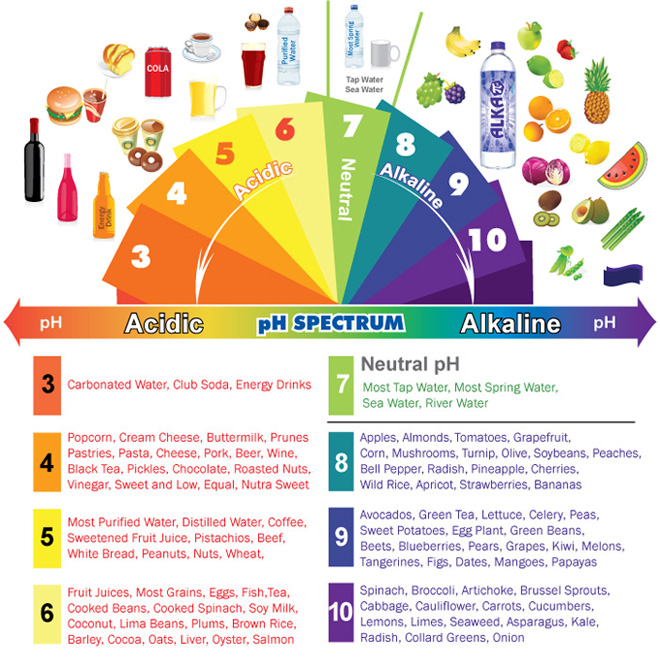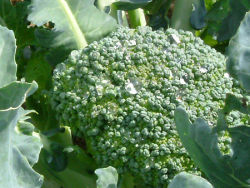All foods, after being digested, release either acid or alkaline bicarbonates into the blood. The higher the protein in foods, like fish, meat, dairy products, poultry and cheese the more acid is produced. Most green vegetables on the other hand are high in minerals and as a consequence produce a more alkaline effect on the blood, so eating protein and vegetables together help to keep your pH ratio in balance. In the human body “power of hydrogen” or “potential of hydrogen” (pH) stands for the acidic and alkaline environment in your body fluids. Your body’s pH is measured on a scale from 1 to 14 with seven being neutral. Below seven is acidic and above seven is alkaline, also referred to as base. Water has a rating of seven making it neutral indicating that it should neither raise nor lower the alkalinity or acidity of your body fluids. Your body should be slightly more alkaline than acidic on a ratio of 51/49 or in a range of 7.35-7.45 alkaline to 6.55-6.65 acidic. Some of the organs in your body, your kidneys (renal system= kidneys, bladder, urethra) and lungs (respiratory system = lungs, throat, bronchial tract) in particular, help to maintain the balance and certain foods once digested are known to increase the acidity or alkalinity of the body. A healthy pH helps to regulate normal cell production. Conversely an unhealthy pH is associated with abnormal cell production, which can be summed up in one word… disease. So, if your body’s pH is not correct there is no chance of curing yourself of any disease.
The acidic/alkaline (base) balance is normally very tightly regulated by “buffering” agents and one of the best is sodium bicarbonate, also known as baking soda, bicarbonate of soda and sometimes simply as bicarb. It has an alkalizing effect on the body’s pH and its own pH is 14, the highest you can get. It is relatively innocuous and if used periodically there is no chance of overdosing. It is a quick acting antacid and can also be used to relieve heartburn, acid reflux and indigestion but should not be used as a long term solution to these problems. It should also be taken at least half an hour before meals and about 2 to 3 hours after a meal. Another buffering agent is potassium citrate which, as the second part of the name suggests, is derived from citrus fruits, especially lemons. A healthy pH balance is contingent upon a balance of potassium and sodium in the body.
I am certain you have heard the expressions, “your body can heal itself” or “your body wants to heal itself”. We often use these statements quite glibly without giving any thought to the serious reality of the sayings. When you have an acidic reading your body tries to return to normal alkalinity because this is where good health lies. One of the ways in which it does this is by taking minerals and nutrients, such as calcium and magnesium, from the bones (skeleton) thereby weakening the said bones. Your skeleton is in fact a calcium larder. Acidic pH is believed to cause problems such as low bone density, fatigue and illness, reduction in the body’s ability to rid itself of heavy metals and restriction of the body’s ability to absorb important nutrients. Keeping a balanced pH is relatively easy as the two most important contributory factors are exercise and diet. Foods have different pH levels and eating certain foods can impact quite significantly on your body’s pH level. Apart from heredity other factors that may cause your body to become acidic are stress, exposure to toxins, and immune deficiencies. An acidic environment gives rise to chronic inflammation which is perhaps the main cause of most degenerative diseases (see the article on “thieves of good health”).
Good pH balance provides the following benefits.
• Proper cholesterol levels
• Healthy circulatory system
• Efficient heart function
• Normal blood sugar levels
• Normal energy levels
• Good bone and digestive health.
• A strong immune system
ALKALIZING FOODS
Sweet Potatoes , Green Vegetables, Coconut , avocados, citrus fruits, curry, peas, pumpkin, bananas, beet, onions, tomatoes, probiotic cultures, cinnamon, ginger, blackstrap molasses, potassium, magnesium, pineapples, musk melons. (Please note that this is not a comprehensive list and that some of the foods mentioned here are more alkalizing than others).
ACID FORMING FOODS
Wheat, meat, sugar, margarine, butter, fish, pasta, spaghetti, cooking oils, rice, soda, crackers, corned beef, soft drinks, soy milk, colas, ice cream, beer, peanuts, cashews, corn syrup, bacon, cocoa, kidney beans, oat bran, medicinal drugs. (Once again please note that this is not a comprehensive list and that some of the foods mentioned here are more acidizing than others).
Some foods are border line and therefore may not be shown in the above list, which is not designed to be a complete selection of alkalinizing or acidizing foods but seeks to highlight those that are highly so. Some foods and fruit like tomatoes, citrus fruits (lemons and limes) are normally acidic but become alkaline when consumed, so a distinction has to be made between acidic foods and acid forming foods.
A diet designed for pH levels will combine acidic and alkaline foods to obtain a pH of 51% alkalinity to 49% acidity, also expressed as, 7.35 alkalinity to 6.65 acidity, as mentioned earlier, which is considered neutral and therefore conducive to good health, remembering of course, that the top number is 14. Testing your pH is relatively simple to do as there are strips that can be bought over the counter at chemist shops, which can indicate the pH when saliva or urine is placed on them. There are times when urine pH can indicate serious health issues. A high alkaline pH, for instance could be a sign of kidney problems or urinary tract infection (UTI) whereas a low acidic pH could indicate lung disease or diabetes. If your urinary pH fluctuates between 6.00 and 6.50 in the morning and 6.50 and 7.00 in the evening your body is functioning within a healthy range and if your saliva stays between 6.50 and 7.50 all day your body is also functioning within a healthy range. The best time to test your pH is about one hour before a meal and two hours after a meal and twice a week.
In our younger years we are naturally alkaline but as we get older we become much more acidic, meaning that we have to look at and address this imbalance more closely by paying particular attention to what we eat. One way to do this, in addition to eating alkalizing foods is to drink a cup of warm (not boiling hot) lemon juice or lime juice and water first thing in the morning and drinking a glass of water with a teaspoonful of bicarbonate of soda at night.
